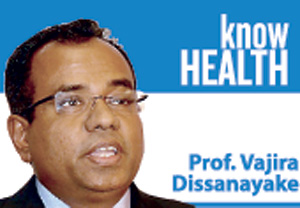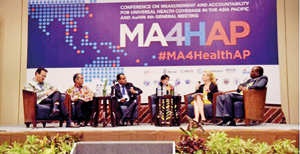Transitioning from MDGs to Sustainable Development Goals: Role of ICT
The eHealth Asia 2015 conference that concluded on October 14 in Colombo, was a resounding success (please visit http://www.ehealthasia.org to access the conference contents). Those of us who have been in the field of Health Informatics in Sri Lanka since the mid-1990s saw a remarkable change at this year’s conference. The change came in the shape of private sector participation. The chairman of one of the largest hospital chains in Sri Lanka, who sat through most of the conference, was to comment to me:
 “Doctor, so much has been happening in the government sector that we (the private sector) need to do more”. He was spot on. If the private sector is to becoming the dominant health care provider in Sri Lanka, they need to do more to keep costs affordable to patients because private sector care in Sri Lanka for the most part is out of pocket and the only way they can do it is by going digital and ensuring that patient outcomes are improved.
“Doctor, so much has been happening in the government sector that we (the private sector) need to do more”. He was spot on. If the private sector is to becoming the dominant health care provider in Sri Lanka, they need to do more to keep costs affordable to patients because private sector care in Sri Lanka for the most part is out of pocket and the only way they can do it is by going digital and ensuring that patient outcomes are improved.
NCDs
Why am I saying this? I am saying this because of the crisis that we are facing in the health care sector today. The crisis comes in the form of non-communicable disorders. If 20 per cent to 25 per cent of our population is affected with these conditions, then we are talking about four million people. The majority of these people are not in hospitals. They are in the community. For every patient warded in a hospital with one of these disorders 1,000 to 10,000 are in the community. That is a staggering number.
So how do we care for them? In between encounters with doctors, we expect patients to take medicines correctly, eat the correct food, avoid smoking and alcohol, exercise regularly, and watch out for warning signs of an acute problem and come to hospital immediately. How do we ensure patient compliance? Can we use digital technologies?
| The 5-Point Call to Action 1. Increase the level and efficiency of investments by governments and development partners to strengthen the country health information system in line with international standards and commitments; 2. Strengthen country institutional capacity to collect, compile, share, disaggregate, analyse, disseminate, and use data at all levels of the health system; 3. Ensure that countries have well-functioning sources for generating population health data, including civil registration and vital statistics systems, censuses, and health surveys tailored to country needs, in line with international standards; 5. Promote country and global governance with citizens’ and community’s participation for accountability through monitoring and regular, inclusive transparent reviews of progress and performance at the facility, subnational, national, regional, and global levels, linked to the health-related SDGs. (Source: http://ma4health.hsaccess.org/roadmap) | |
The World Health Organisation and the International Telecommunications Union believe that mobile technologies would be the answer to this problem. In October 2012, the WHO and ITU launched their ‘BE HE@LTHY, BE MOBILE’ initiative. The initiative is aimed at encouraging people to use mobile technologies to change behaviour and monitor their health. I shall talk about it more in my future columns.
 Right on the heels of the eHealth Asia conference the leaders in eHealth in the Asia Pacific Region met in Bali, Indonesia, October 26-30 at the 4th Asia eHealth Information Network General Meeting on the theme “Measurement and Accountability for Universal Health Coverage in the Asia Pacific Region”. I had the privilege of moderating the opening plenary of the conference, where my panel discussed “Where are we now: Transitioning from the Millennium Development Goals to Sustainable Development Goals:
Right on the heels of the eHealth Asia conference the leaders in eHealth in the Asia Pacific Region met in Bali, Indonesia, October 26-30 at the 4th Asia eHealth Information Network General Meeting on the theme “Measurement and Accountability for Universal Health Coverage in the Asia Pacific Region”. I had the privilege of moderating the opening plenary of the conference, where my panel discussed “Where are we now: Transitioning from the Millennium Development Goals to Sustainable Development Goals:
Measurement and Accountability for Health in the Post 2015 Development Agenda and the Role of ICT”.
MDGs and SDGs
As you may know, from 2000 to 2015, the United Nation’s global agenda for development was aimed at achieving the Millennium Development Goals (MDGs).
The post 2015 agenda, ending in 2030, will be on Sustainable Development Goals (SGDs). In terms of MDGs, there were three goals, six targets and 21 indicators for the health sector. In the SGDs context, there will be one goal, 13 targets and 25 or more indicators for the health sector. To meet these new requirements for accountability, many countries will have to embark on revising their national health information systems. In June 2015, state and non-state actors participated in the “Measurement and Accountability for Results in Health” conference convened by the World Bank, World Health Organisation and USAID in Washington, DC. They released a five-point call to action encouraging countries to prepare for the new agenda (see box).
My panellists (see picture) shared their experiences with measurement and accountability for health during the past 15 years, shared their insights about the post 2015 development agenda and the SDGs, and shared perspectives or lessons learned from MDGs that could inform the new measurements for accountability for SDGs and what they perceived as the role of information and communication technology (ICT) in the future. In the process, they faced tough questions from both the moderator and the audience on their experience with measuring performance with the MDGs, their current assessment of the state of Universal Health Coverage, their thoughts on the post 2015 development agenda, on the SDGs and its impact, and the role of ICT on health systems performance. The recurring theme in all the answers was that not enough was done in the past 15 years, more has to be done in the next 15 years and that this cannot be done without widespread and appropriate use of ICT in the health sector, aimed at improving business processes and better health outcomes for patients. These are important questions for us in Sri Lanka to reflect on, as we go forward with Digital Health in Sri Lanka.
(The writer is the President, Health Informatics Society of Sri Lanka; the Past President, Sri Lanka Medical Association; the President-Elect, Commonwealth Medical Association; and a Fellow of the National Academy of Sciences of Sri Lanka. He can be contacted via vajirahwd@hotmail.com).


